Researchers develop novel method to insert large DNA sequences more accurately in cells
Posted: 23 January 2023 | Ria Kakkad (Drug Target Review) | No comments yet
The scientists say that the engineered CRISPR enzymes could overcome key limitations for eventual use to treat genetic diseases irrespective of a patient’s particular mutation.


Investigators at Massachusetts General Hospital (MGH), US, recently developed an optimised method that improves the accuracy of inserting large DNA segments into a genome.
This approach could be used to insert a whole normal or “wild-type” replacement gene, which could act as a blanket therapy for a disease irrespective of a patient’s particular mutation.
The work involves the optimisation of a new class of technologies called CRISPR-associated transposases (CASTs), which are promising tools for large DNA insertions that can be easily targeted to a desired genomic site via a reprogrammable guide RNA.
However, in their natural state, CASTs have undesirable properties for genome editing applications — namely, suboptimal product purity (how often only the intended DNA sequence is inserted into the genome) and a relatively high rate of unwanted off-target integration at unintended sites in the genome.
In their research published in Nature Biotechnology, the team addressed these shortcomings by using protein engineering approaches to modify the properties of CAST systems.
They found that adding a certain enzyme called a nicking homing endonuclease to CASTs resulted in a dramatic increase in product purity towards the intended insertion.
Further optimisation of CASTs’ structure led to DNA insertions with high integration efficiency at intended genomic targets with vastly reduced insertions at unwanted off-targets sites.
The researchers called the new and improved system Homing Endonuclease-assisted Large-sequence Integrating CAST-compleX (HELIX).
“We demonstrated a generalisable approach that can be used to modify a variety of CAST systems into safer and more effective versions that have high product purity and genome-wide specificity,” said first author Connor Tou.
“By combining our insights, we created HELIX systems with greater than 96 percent on-target integration specificity —increased from approximately 50 percent for the naturally occurring wild-type CAST system. We also determined that HELIX maintains its advantageous properties in human cells.”
The researchers note that the technology could have applications beyond the ability to restore normal healthy genes to individuals with disease-causing mutations.
“Additionally, programmable DNA integration can facilitate cell engineering efforts where installation of large genetic sequences at targeted locations could endow cells with new capabilities while obviating safety, efficacy, and manufacturing issues resulting from traditional random integration approaches,” concluded Dr Ben Kleinstiver.
Related topics
CRISPR, DNA, Gene Therapy, Genome Editing, Genomics, Sequencing
Related organisations
Massachusetts General Hospital (MGH)
Related people
Connor Tou, Dr Ben Kleinstiver








